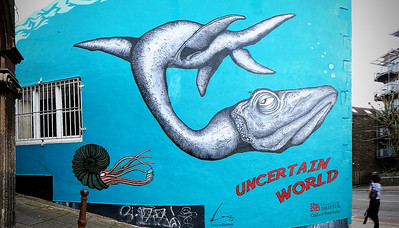Archive for the ‘Uncertainty’ Category
When I’m Asked To Take On New Work
 Here are the questions I ask myself when I’m asked to take on new work….
Here are the questions I ask myself when I’m asked to take on new work….
Do I know what the work is all about?
Is it well-defined?
Would it make a big difference if the work is completed successfully?
Would it make a big difference if it’s not?
Is it clear how to judge if the work is completed successfully?
Is the work important and how do I know?
Is it urgent? (The previous question is far more important to me.)
Is there more important work?
Who would benefit from the work and how do I feel about it?
Would I benefit and how do I feel about it?
Am I uniquely qualified or can others do the work?
Am I interested in the work?
Would I grow from the work?
Who would I work for?
Who would I work with?
Would my career progress?
Would I get a raise?
Would I spend more time with my family?
Would I spend more time in meetings?
Would I travel more?
What does my Trust Network think?
Would I have fun? (I think this is a powerful question.)
These aren’t the questions you should ask yourself, but I hope the list helps you develop your own.
Image credit — broombesoom
Swimming In New Soup
 You know the space is new when you don’t have the right words to describe the phenomenon.
You know the space is new when you don’t have the right words to describe the phenomenon.
When there are two opposite sequences of events and you think both are right, you know the space is new.
You know you’re thinking about new things when the harder you try to figure it out the less you know.
You know the space is outside your experience but within your knowledge when you know what to do but you don’t know why.
When you can see the concept in your head but can’t drag it to the whiteboard, you’re swimming in new soup.
When you come back from a walk with a solution to a problem you haven’t yet met, you’re circling new space.
And it’s the same when know what should be but it isn’t – circling new space.
When your old tricks are irrelevant, you’re digging in a new sandbox.
When you come up with a new trick but the audience doesn’t care – new space.
When you know how an experiment will turn out and it turns out you ran an irrational experiment – new space.
When everyone disagrees, the disagreement is a surrogate for the new space.
It’s vital to recognize when you’re swimming in a new space. There is design freedom, new solutions to new problems, growth potential, learning, and excitement. There’s acknowledgment that the old ways won’t cut it. There’s permission to try.
And it’s vital to recognize when you’re squatting in an old space because there’s an acknowledgment that the old ways haven’t cut it. And there’s permission to wander toward a new space.
Image credit — Tambaco The Jaguar
Working In Domains of High Uncertainty
 X: When will you be done with the project?
X: When will you be done with the project?
Me: This work has never been done before, so I don’t know.
X: But the Leadership Team just asked me when the project will be done. So, what should I say?
Me: Since nothing has changed since the last time you asked me, I still don’t know. Tell them I don’t know.
X: They won’t like that answer.
Me: They may not like the answer, but it’s the truth. And I like telling the truth.
X: Well, what are the steps you’ll take to complete the project?
Me: All I can tell you is what we’re trying to learn right now.
X: So all you can tell me is the work you’re doing right now?
Me: Yes.
X: It seems like you don’t know what you’re doing.
Me: I know what we’re doing right now.
X: But you don’t know what’s next?
Me: How could I? If this current experiment goes up in smoke, the next thing we’ll do is start a different project. And if the experiment works, we’ll do the next right thing.
X: So the project could end tomorrow?
Me: That’s right.
X: Or it could go on for a long time?
Me: That’s right too.
X: Are you always like this?
Me: Yes, I am always truthful.
X: I don’t like your answers. Maybe we should find someone else to run the project.
Me: That’s up to you. But if the new person tells you they know when the project will be done, they’re the wrong person to run the project. Any date they give you will be a guess. And I would not want to be the one to deliver a date like that to the Leadership Team.
X: We planned for the project to be done by the end of the year with incremental revenue starting in the first quarter of next year.
Me: Well, the project work is not bound by the revenue plan. It’s the other way around.
X: So, you don’t care about the profitability of the company?
Me: Of course I care. That’s why we chose this project – to provide novel customer value and sell more products.
X: So the project is intended to deliver new value to our customers?
Me: Yes, that’s how the project was justified. We started with an important problem that, if solved, would make them more profitable.
X: So you’re not just playing around in the lab.
Me: No, we’re trying to solve a customer problem as fast as we can. It only looks like we’re playing around.
X: If it works, would our company be more profitable?
Me: Absolutely.
X: Well, how can I help?
Me: Please meet with the Leadership Team and thank them for trusting us with this important project. And tell them we’re working as fast as we can.
Image credit – Florida Fish and Wildlife
X: Me: format stolen from Simon Wardley (@swardley). Thank you, Simon.
If you want to change things, do a demo.
 When you demo something new, you make the technology real. No longer can they say – that’s not possible.
When you demo something new, you make the technology real. No longer can they say – that’s not possible.
When you demo something new, you help people see what it is and what it isn’t. And that brings clarity.
When you demo something new, people take sides. And that says a lot about them.
When you demo something new, be prepared to demo it again. It takes time for people to internalize new concepts.
When someone asks you to repeat the demo so others can see it, it’s a sign there’s something interesting about the demo. Repeat it.
When someone calls out fault with a minor element of the demo, they also reinforce the strength of the main elements.
When you demo something new and it works perfectly, you should have demo’d it sooner.
When the demo works perfectly, you’re not trying hard enough.
When you demo something new, there is no way to predict the action items spawned by the demo. In fact, the reason to do the demo is to learn the next action items.
When you demo something new, make the demo short so the conversation can be long.
When you demo something new, shut your mouth and let the demo do the talking.
When you demo something new, keep track of the questions that arise. Those questions will inform the next demo.
When you demo something new and it’s misunderstood, congratulations. You’ve helped the audience loosen their thinking.
If you want to change people’s thinking, do a demo.
Image credit – Ralf Steinberger
When You Don’t Know What To Do…
 When you don’t know what to do, what do you do? This is a difficult question.
When you don’t know what to do, what do you do? This is a difficult question.
Here are some thoughts that may help you figure out what to do when you really don’t know.
Don’t confuse activity with progress.
Gather your two best friends, go off-site, and define the system as it is.
Don’t ask everyone what they think because the Collective’s thoughts will be diffuse, bland, and tired.
Get outside.
Draw a picture of how things work today.
Get a good meal.
Make a graph of goodness over time. If it’s still increasing, do more of what you did last time. If it’s flat, do something else.
Get some exercise.
Don’t judge yourself negatively. This is difficult work.
Get some sleep.
Help someone with their problem. The distraction will keep you out of the way as your mind works on it for you.
Spend time with friends.
Try a new idea at the smallest scale. It will likely lead to a better one. Repeat.
Use your best judgment.
Image credit – Andrew Gustar
Three Things for the New Year
 Next year will be different, but we don’t know how it will be different. All we know is that it will be different.
Next year will be different, but we don’t know how it will be different. All we know is that it will be different.
Some things will be the same and some will be different. The trouble is that we won’t know which is which until we do. We can speculate on how it will be different, but the Universe doesn’t care about our speculation. Sure, it can be helpful to think about how things may go, but as long as we hold on to the may-ness of our speculations. And we don’t know when we’ll know. We’ll know when we know, but no sooner. Even when the Operating Plan declares the hardest of hard dates, the Universe sets the learning schedule on its own terms, and it doesn’t care about our arbitrary timelines.
What to do?
Step 1. Try three new things. Choose things that are interesting and try them. Try to try them in parallel as they may interact and inform each other. Before you start, define what success looks like and what you’ll do if they’re successful and if they’re not. Defining the follow-on actions will help you keep the scope small. For things that work out, you’ll struggle to allocate resources for the next stages, so start small. And if things don’t work out, you’ll want to say that the projects consumed little resources and learned a lot. Keep things small. And if that doesn’t work, keep them smaller.
Step 2. Rinse and repeat.
I wish you a happy and safe New Year. And thanks for reading.
Mike
“three” by Travelways.com is licensed under CC BY 2.0
Your core business is your greatest strength and your greatest weakness.
 Your core business, the long-standing business that has made you what you are, is both your greatest strength and your greatest weakness.
Your core business, the long-standing business that has made you what you are, is both your greatest strength and your greatest weakness.
The Core generates the revenue, but it also starves fledgling businesses so they never make it off the ground.
There’s a certainty with the Core because it builds on success, but its success sets the certainty threshold too high for new businesses. And due to the relatively high level of uncertainty of the new business (as compared to the Core) the company can’t find the gumption to make the critical investments needed to reach orbit.
The Core has generated profits over the decades and those profits have been used to create the critical infrastructure that makes its success easier to achieve. The internal startup can’t use the Core’s infrastructure because the Core doesn’t share. And the Core has the power to block all others from taking advantage of the infrastructure it created.
The Core has grown revenue year-on-year and has used that revenue to build out specialized support teams that keep the flywheel moving. And because the Core paid for and shaped the teams, their support fits the Core like a glove. A new offering with a new value proposition and new business model cannot use the specialized support teams effectively because the new offering needs otherly-specialized support and because the Core doesn’t share.
The Core pays the bills, and new ventures create bills that the Core doesn’t like to pay.
If the internal startup has to compete with the Core for funding, the internal startup will fail.
If the new venture has to generate profits similar to the Core, the venture will be a misadventure.
If the new offering has to compete with the Core for sales and marketing support, don’t bother.
If the fledgling business’s metrics are assessed like the Core’s metrics, it won’t fly, it will flounder.
If you try to run a new business from within the Core, the Core will eat it.
To work effectively with the Core, borrow its resources, forget how it does the work, and run away.
To protect your new ventures from the Core, physically separate them from the Core.
To protect your new businesses from the Core, create a separate budget that the Core cannot reach.
To protect your internal startup from the Core, make sure it needs nothing from the Core.
To accelerate the growth of the fledgling business, make it safe to violate the Core’s first principles.
To bolster the capability of your new business, move resources from the Core to the new business.
To de-risk the internal startup, move functional support resources from the Core to the startup.
To fund your new ventures, tax the Core. It’s the only way.
“Core Memory” by JD Hancock is licensed under CC BY 2.0
Everyone is doing their best, even though it might not look that way.
 In these trying times when stress is high, supply chains are empty, and the pandemic is still alive and well, here’s a mantra to hold onto:
In these trying times when stress is high, supply chains are empty, and the pandemic is still alive and well, here’s a mantra to hold onto:
Everyone is doing their best, even though it might not look that way.
When restaurants are only open four days a week because they have no one to take the orders and clean the dishes, they are trying their best. Sure, you can’t go there for dinner on those off-days. And, sure, it cramps your style. And, sure, it looks like they’re doing it just to piss you off. But they are trying their best. They want to be open. They want to serve you dinner and take your money. It may not look like it, but they are doing their best. How might you hold onto that reality? How might you engage your best self and respond accordingly?
The situation at restaurants is one of many where people are trying their best but environmental realities have caused their best to be less than it was. Car dealers want to sell cars, but there are fewer of them to sell. The prices are higher, the choices are fewer, and the lead times are longer. The salespeople aren’t out to get you; there’s simply more demand than cars. If you want a car, try to buy one. But if you can’t or you don’t like the price, what does it say about you if you get angry at the salesperson? It may not look like it, but they are trying their best. How might you hold onto that? What would it take for you to behave like they are trying their best?
Plumbers and electricians have more work than they can handle. If they don’t answer their phone, or don’t respond quickly, or respond with a quote that’s higher than you think reasonable, don’t take it personally. They are doing their best. Plumbers actually like to trade their time for your money and it’s the same with electricians. But, there are simply more pipes to be worked on than there are plumbers to work them. And there’s more wiring to do than there are electricians to do work. Their best isn’t as good as it was, but it’s still their best. You can get angry, but that won’t get your leaks fixed or your new electrical outlets installed. How might you hold onto the fact that they are doing their best? And, how might you engage your best self to respond with kindness and understanding?
And it’s the same situation at work. Everyone is trying their best, though it may look that way. Our families or parents are struggling; our kids are having a difficult time; we can’t find plumbers; we can’t hire electricians; we cannot afford new cars prices; there are no cars to buy; and the restaurants are closed. This is crazy enough on its own, but all those outside stressors are sitting on top of a collection of work-related stressors. There are many vacant positions so there are fewer people to do the work; competitors have upped the pressure; under the banner of doing more with less, more projects have been added, even though there are fewer people; and profitability goals have been turned up to eleven.
How might we hold onto the reality that our personal lives are stressful and, though we are trying harder than ever, our best CANNOT be good as it used to be? And how might we hold onto the reality that with such stress at home, we are giving our all but we have LESS to give.
Let’s help each other hold onto the mantra:
Everyone is doing their best, even though it might not look that way.
“the mask” by wolfgangfoto is licensed under CC BY-ND 2.0
A Leading Indicator of Personal Growth — Fear
 When was the last time you did something that scared you? And a more important follow-on question: How did you push through your fear and turn it into action?
When was the last time you did something that scared you? And a more important follow-on question: How did you push through your fear and turn it into action?
Fear is real. Our bodies make it, but it’s real. And the feelings we create around fear are real, and so are the inhibitions we wrap around those feelings. But because we have the authority to make the fear, create the feelings, and wrap the inhibitions, we also have the authority to unmake, un-create, and unwrap.
Fear can feel strong. Whether it’s tightness in the gut, coldness in the chest, or lushness in the face, the physical manifestations in the body are recognizable and powerful. The sensations around fear are strong enough to stop us in our tracks. And in the wild of a bygone time, that was fear’s job – to stop us from making a mistake that would kill us. And though we no longer venture into the wild, fear responds to family dynamics, social situations, interactions at work, as if we still live in the wild.
To dampen the impact of our bodies’ fear response, the first step is to learn to recognize the physical sensations of fear for what they are – sensations we make when new situations arise. To do that, feel the sensations, acknowledge your body made them, and look for the novelty, or divergence from our expectations, that the sensations stand for. In that way, you can move from paralysis to analysis. You can move from fear as a blocker to fear as a leading indicator of personal growth.
Fear is powerful, and it knows how to create bodily sensations that scare us. But, that’s the chink in the armor that fear doesn’t want us to know. Fear is afraid to be called by name, so it generates these scary sensations so it can go on controlling our lives as it sees fit. So, next time you feel the sensations of fear in your body, welcome fear warmly and call it by name. Say something like, “Hello Fear. Thank you for visiting with me. I’d like to get to know you better. Can you stay for a coffee?”
You might find that Fear will engage in a discussion with you and apologize for causing you trouble. Fear may confess that it doesn’t like how it treats you and acknowledge that it doesn’t know how to change its ways. Or, it may become afraid and squirt more fear sensations into your body. If that happens, tell Fear that you understand it’s just doing what it evolved to do, and repeat your offer to sit with it and learn more about its ways.
The objective of calling Fear by name is to give you a process to feel and validate the sensations and then calm yourself by looking deeply at the novelty of the situation. By looking squarely into Fear’s eyes, it will slowly evaporate to reveal the nugget of novelty it was cloaking. And with the novelty in your sights, you can look deeply at this new situation (or context or interpersonal dynamic) and understand it for what it is. Without Fear’s distracting sensations, you will be pleasantly surprised with your ability to see the situation for what it is and take skillful action.
So, when Fear comes, feel the sensations. Don’t push them away. Instead, call Fear by name. Invite Fear to tell its story, and get to know it. You may find that accepting Fear for what it is can help you grow your relationship with Fear into a partnership where you help each other grow.
“tractor pull 02 – Arnegard ND – 2013-07-04” by Tim Evanson is licensed under CC BY-SA 2.0
How To See What’s Missing
 With one eye open and the other closed, you have no depth perception. With two eyes open, you see in three dimensions. This ability to see in three dimensions is possible because each eye sees from a unique perspective. The brain knits together the two unique perspectives so you can see the world as it is. Or, as your brain thinks it is, at least.
With one eye open and the other closed, you have no depth perception. With two eyes open, you see in three dimensions. This ability to see in three dimensions is possible because each eye sees from a unique perspective. The brain knits together the two unique perspectives so you can see the world as it is. Or, as your brain thinks it is, at least.
And the same can be said for an organization. When everyone sees things from a single perspective, the organization has no depth perception. But with at least two perspectives, the organization can better see things as they are. The problem is we’re not taught to see from unique perspectives.
With most presentations, the material is delivered from a single perspective with the intention of helping everyone see from that singular perspective. Because there’s no depth to the presentation, it looks the same whether you look at it with one eye or two. But with some training, you can learn how to see depth even when it has purposely been scraped away.
And it’s the same with reports, proposals, and plans. They are usually written from a single perspective with the objective of helping everyone reach a single conclusion. But with some practice, you can learn to see what’s missing to better see things as they are.
When you see what’s missing, you see things in stereo vision.
Here are some tips to help you see what’s missing. Try them out next time you watch a presentation or read a report, proposal, or plan.
When you see a WHAT, look for the missing WHY on the top and HOW on the bottom. Often, at least one slice of bread is missing from the why-what-how sandwich.
When you see a HOW, look for the missing WHO and WHEN. Usually, the bread or meat is missing from the how-who-when sandwich.
Here’s a rule to live by: Without finishing there can be no starting.
When you see a long list of new projects, tasks, or initiatives that will start next year, look for the missing list of activities that would have to stop in order for the new ones to start.
When you see lots of starting, you’ll see a lot of missing finishing.
When you see a proposal to demonstrate something for the first time or an initial pilot, look for the missing resources for the “then what” work. After the prototype is successful, then what? After the pilot is successful, then what? Look for the missing “then what” resources needed to scale the work. It won’t be there.
When you see a plan that requires new capabilities, look for the missing training plan that must be completed before the new work can be done well. And look for the missing budget that won’t be used to pay for the training plan that won’t happen.
When you see an increased output from a system, look for the missing investment needed to make it happen, the missing lead time to get approval for the missing investment, and the missing lead time to put things in place in time to achieve the increased output that won’t be realized.
When you see a completion date, look for the missing breakdown of the work content that wasn’t used to arbitrarily set the completion date that won’t be met.
When you see a cost reduction goal, look for the missing resources that won’t be freed up from other projects to do the cost reduction work that won’t get done.
It’s difficult to see what’s missing. I hope you find these tips helpful.
“missing pieces” by LeaESQUE is licensed under CC BY-ND 2.0
Certainty or novelty – it’s your choice.
 When you follow the best practice, by definition your work is not new. New work is never done the same way twice. That’s why it’s called new.
When you follow the best practice, by definition your work is not new. New work is never done the same way twice. That’s why it’s called new.
Best practices are for old work. Usually, it’s work that was successful last time. But just as you can never step into the same stream twice, when you repeat a successful recipe it’s not the same recipe. Almost everything is different from last time. The economy is different, the competitors are different, the customers are in a different phase of their lives, the political climate is different, interest rates are different, laws are different, tariffs are different, the technology is different, and the people doing the work are different. Just because work was successful last time doesn’t mean that the old work done in a new context will be successful next time. The most important property of old work is the certainty that it will run out of gas.
When someone asks you to follow the best practice, they prioritize certainty over novelty. And because the context is different, that certainty is misplaced.
We have a funny relationship with certainty. At every turn, we try to increase certainty by doing what we did last time. But the only thing certain with that strategy is that it will run out of gas. Yet, frantically waving the flag of certainty, we continue to double down on what we did last time. When we demand certainty, we demand old work. As a company, you can have too much “certainty.”
When you flog the teams because they have too much uncertainty, you flog out all the novelty.
What if you start the design review with the question “What’s novel about this project?” And when the team says there’s nothing novel, what if you say “Well, go back to the drawing board and come back with some novelty.”? If you seek out novelty instead of squelching it, you’ll get more novelty. That’s a rule, though not limited to novelty.
A bias toward best practices is a bias toward old work. And the belief underpinning those biases is the belief that the Universe is static. And the one thing the Universe doesn’t like to be called is static. The Universe prides itself on its dynamic character and unpredictable nature. And the Universe isn’t above using karma to punish those who call it names.
“Stonecold certainty” by philwirks is licensed under CC BY-ND 2.0
 Mike Shipulski
Mike Shipulski